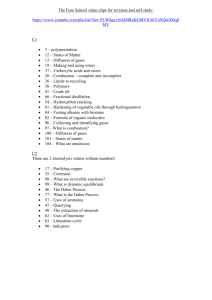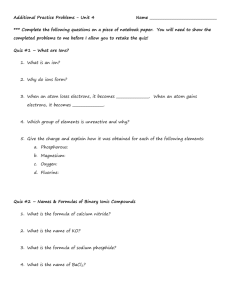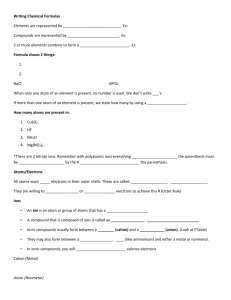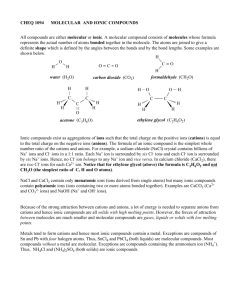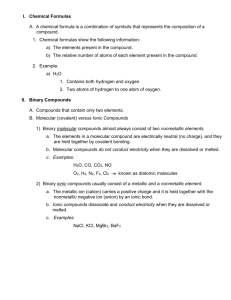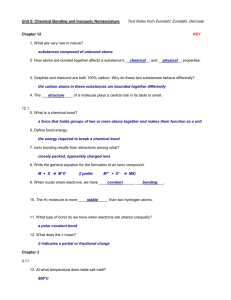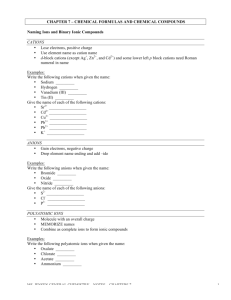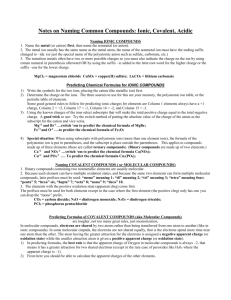Chem 2 Ch. 2, Part 2 Outline and Hmwk F2015 2.5 Molecules and
advertisement
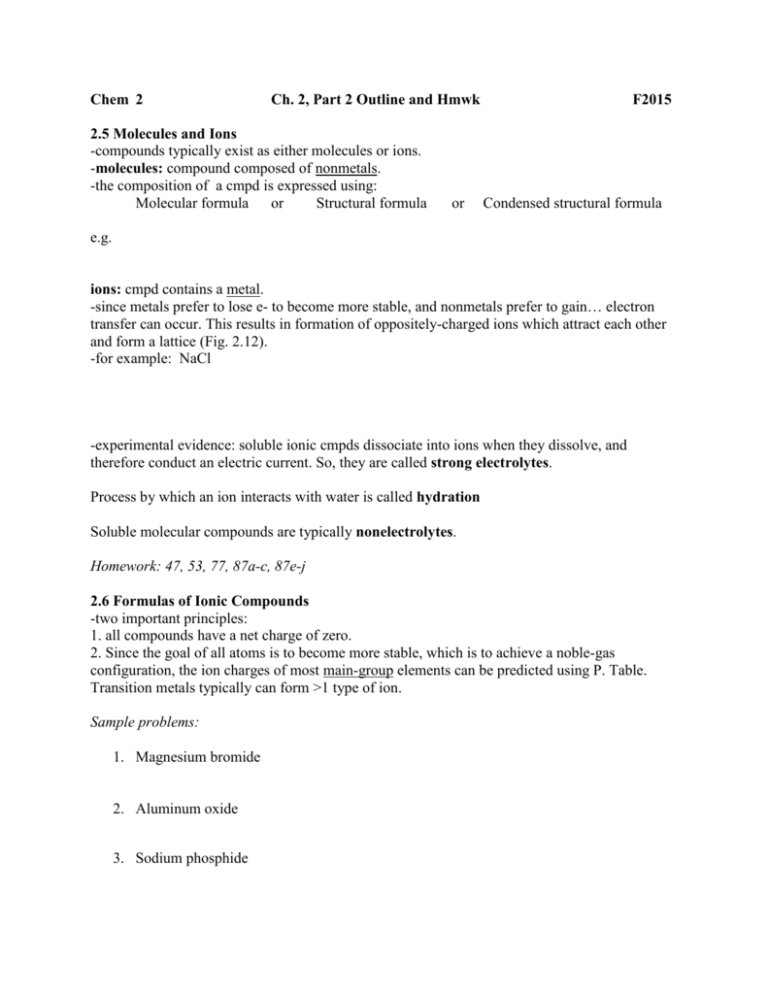
Chem 2 Ch. 2, Part 2 Outline and Hmwk 2.5 Molecules and Ions -compounds typically exist as either molecules or ions. -molecules: compound composed of nonmetals. -the composition of a cmpd is expressed using: Molecular formula or Structural formula or F2015 Condensed structural formula e.g. ions: cmpd contains a metal. -since metals prefer to lose e- to become more stable, and nonmetals prefer to gain… electron transfer can occur. This results in formation of oppositely-charged ions which attract each other and form a lattice (Fig. 2.12). -for example: NaCl -experimental evidence: soluble ionic cmpds dissociate into ions when they dissolve, and therefore conduct an electric current. So, they are called strong electrolytes. Process by which an ion interacts with water is called hydration Soluble molecular compounds are typically nonelectrolytes. Homework: 47, 53, 77, 87a-c, 87e-j 2.6 Formulas of Ionic Compounds -two important principles: 1. all compounds have a net charge of zero. 2. Since the goal of all atoms is to become more stable, which is to achieve a noble-gas configuration, the ion charges of most main-group elements can be predicted using P. Table. Transition metals typically can form >1 type of ion. Sample problems: 1. Magnesium bromide 2. Aluminum oxide 3. Sodium phosphide 2.7 Naming Compounds -before we can learn the rules for naming simple cmpds, we have to be able to classify cmpds into 5 different categories, which are: 1. 2. 3. 4. 5. Binary Ionic: two elements- one metal, one NM Ternary Ionic: more than 2 elements, one is a metal Binary Molecular: two NM Binary acid: H + NM in aqueous solution Ternary acid: composed of H, NM, and O -we will practice classifying examples of these 5 types of cmpds. Ionic Compounds -the key to naming ionic cmpds is to be able to name the ions they contain. 1. Cations (+ charge) -main-group metals: name of metal, followed by “ion”. -transition metals: often form >1 ion, so we need to specify the charge. Use the Stock system- a Roman numeral is used to specify the charge on the cation. e.g. Fe 2+ is iron(II) 2. Anions (- charge) -monoatomic: use –ide suffix -polyatomic: -ate vs. –ite (Table 2.2 will eventually need to be memorized, both names and charges!!) To name ionic cmpds: simply name the cation first, then the anion Examples: write a proper name or formula for: Cu2S Fe2O3 Ni(MnO4)2 Aluminum cyanide Hg2O Hmwk: 61a-c, 61de, 63a-c, 63de, 65c-e, 69 To name binary molecular compounds: -since these are molecular compounds, there are no ions…no charges to specify! -use Greek prefixes (Table 2.4) to specify the number of atoms for each NM. -samples- write a proper name or formula for: CO2 N2O5 To name acids (in aqueous solution) -how do we recognize acids from their chemical formula? -Binary Acids: named via: hydro-NM stem-ic acid -examples: HBr (aq) H2S (aq) -Ternary Acids: named using suffixes and your knowledge of polyatomic ions if polyatomic anion ends in “–ate”, then the acid will end in “-ic acid” if polyatomic anion ends in “–ite”, then the acid will end in “-ous acid” -examples: HNO3 (aq) HNO2 (aq) H2SO4 (aq) Homework: 55bde, 65ab, 67, 73



